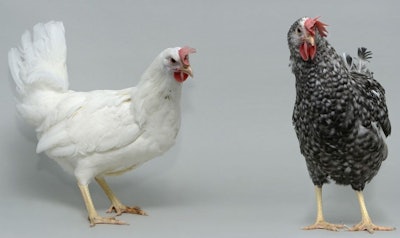
While some things may seem to be never-ending, for others time flies. The latter would now appear to be the case in improving chicken genetics. Gene editing work carried out at the U.K.’s Roslin Institute has demonstrated an efficient way of introducing beneficial characteristics from one chicken breed to another within just a single generation.
The institute’s scientists removed reproductive stem cells from chicken embryos using gene editing technology and then, using the same technology to introduce gene edits into these cells from another breed.
The altered cells were then introduced into the embryos of chicks that were bred to be sterile. The embryos were then hatched and mated with one another.
The resulting offspring were of the donor breed, not that of the surrogates. They also had new traits that that had been created by gene editing.
Safeguarding future production
The development could allow the transfer of useful traits from and to any of the known 1,600 chicken breeds, potentially benefitting productivity and welfare, and helping to safeguard poultry production against changing environmental conditions.
For example, in one of the Roslin studies, curly feathers, which are thought to help Western African breeds cope with heat, were introduced into the UK Light Sussex breed.
Where indigenous breeds are concerned, it may be possible to share beneficial traits, leading to healthier and more productive birds and this could be of particular benefit to poultry production in low- and middle-income countries.
The Roslin team worked with the Center for Tropical Livestock Genetics and Cobb Europe, with funding coming from the Bill and Melinda Gates Foundation.

















